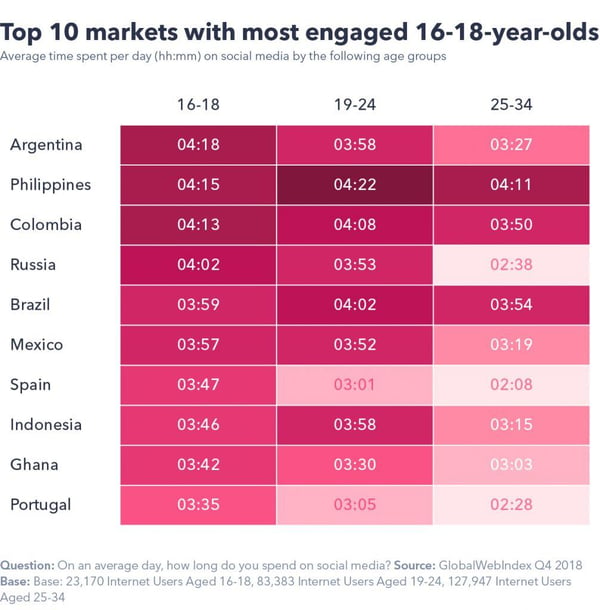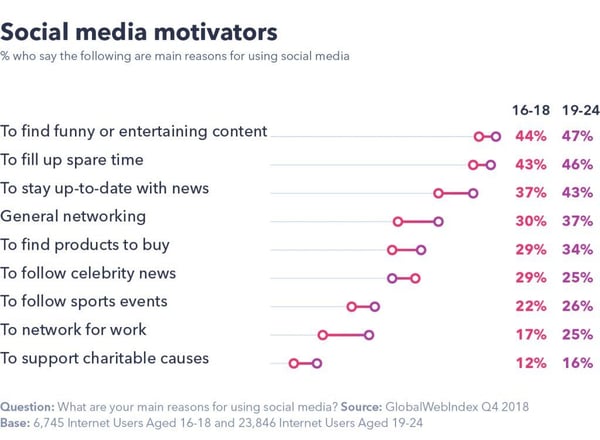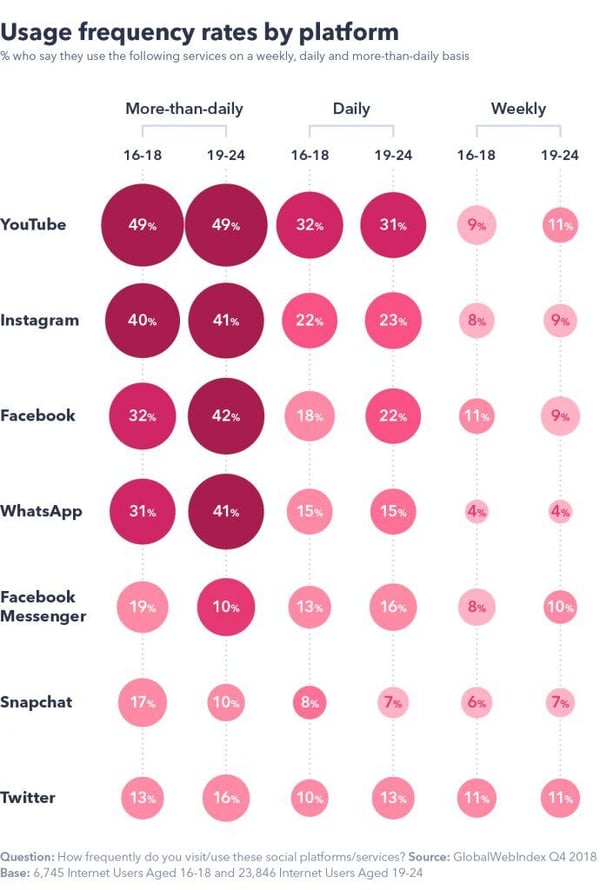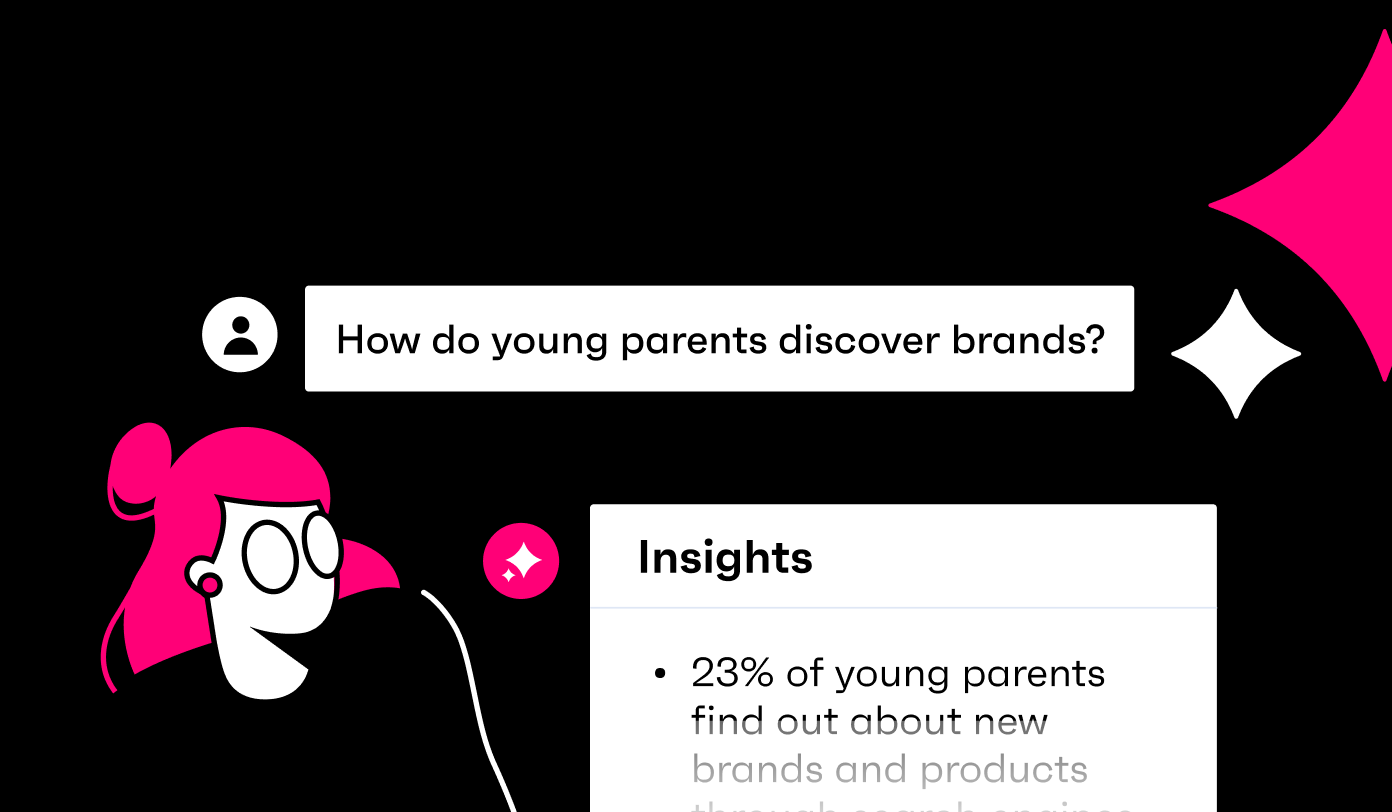It may be simpler for marketers to segment consumers into easily separated ‘generations’, but there’s always the risk of generalizing traits in such a way that meaningful learnings become diffused.
This is especially true for millennials – born between 1981 and 1996 – with the word ‘millennial’ becoming a vague buzzword.
To avoid the same fate for our youngest consumers, we’re taking a closer look at another key target audience group: 16-18 year-olds.
Namely, how teenagers who are likely still yet to leave their parents’ homes, and are in some form of education, use social media, compared 19-24 year-olds who will be in the initial stages of their careers.
An in-depth understanding of the relationship between teenagers and social media, as well as the forces that drive this subset online is well worth pursuing given that Gen Z is poised to outnumber millennials by the end of the year.
How much time do teenagers spend on social media?
The social networking industry has begun to face a reckoning over the past 2-3 years.
Namely over how much time we spend on various platforms, social media’s impact on youth, continued indictments and scandals over how content should be moderated, and how much responsibility platforms should take for enabling the spread of fake news.
One important consequence of social media being put under a microscope is the emergence of digital wellbeing tools as a major industry trend for 2019, with the biggest brands offering functionalities that help users track and control their screen time and control usage habits.
45% of 13-17 year-olds say they’re online on a “near-constant basis”.
This seems to be a particular worry for younger internet users, but how long do our youngest consumers actually spend on social media?
Our data suggests time spent on social media for 16-18 year-olds varies from an average of just over two hours per day in the APAC region to up to over four hours per day in Latin America.
Of the six markets where time on social media per day is highest, all four of our tracked Latin American markets are present.
Argentina comes out on top out of all markets, with teenagers spending an impressive 4 hours 18 minutes on social platforms per day.
Young consumers in Latin America are also spending the longest time online via mobile each day – where social media is most accessible, anytime and anywhere. The widespread popularity of WhatsApp in this region is a decisive factor here.
It’s worth mentioning that this media consumption is simultaneous rather than sequential. That is, consumers are going on social media while they also do other activities; 68% of 16-18s say they use social media while watching TV.
There is also very high engagement in Russia. Teenagers here are typically spending just over 4 hours per day socially connected.
With significant growth in internet usage in part due to the increased consumption of online news and information by Russian internet users – perhaps as a direct response to increased political instability at home and abroad – but also because of their own unique ecosystem of social platforms.
Despite Western platforms having an official presence in Russia, home-grown network, VK, boasts significantly higher figures than Facebook and Instagram both for membership and monthly visitation.
9 in 10 16-18 year-olds in Russia have visited VK in the past month; compared to only 37% who have visited Facebook in the same timeframe.
Other platforms, such as networking sites Moir Mir and Odnoklassniki both have impressive engagement too.

When we compare the time spent on social media by 16-18s, 19-24s, and 25-34s, some clear patterns emerge.
It’s generally true that 25-34s spend the least time on social media compared to younger groups, apart from a few markets such as India, Turkey and Brazil, where 25-34s are the most engaged on social platforms.
There’s a much more regional variation when comparing 16-18s and 19-24s.
In the Asia Pacific region, for instance, it is only in New Zealand, Brazil and South Korea where our youngest respondents spend more time on social media compared to their older counterparts.
In the 11 other markets, 19-24s can spend anywhere up to 30 minutes more on average per day than 16-18s, as is the case in Hong Kong and Malaysia.
Compare this to European respondents, and the pattern is reversed. Out of the 17 markets we track in Europe, 16-18s spend more time on social media than 19-24s in 15 of them.
Why do teenagers use social media?
16-18 year-olds are typically less likely to have more professional motivations for using social media; there is a 32% difference between them and 19-24s for using social media to network for work, and a 19% difference for using it to network with other people.

Perhaps more surprisingly, there’s also a relatively large difference between these groups for using social media to stay up-to-date with news and current events.
Given that roughly the same proportion of both groups fall within our informed* attitudinal segment, as well as generally being considered a very socially aware and connected group, 16-18s are still less likely than the global average to use social media for news.
The only motivation for using social media that 16-18s cite to a greater degree than 19-24s is for following celebrities and celeb news; they’re 1.5x more likely than the average internet user to cite this reason.
Delving a little deeper into these reasons may also provide some explanation for these regional differences in the amount of time spent there.
Whereas in most regions, finding entertaining content is cited by 50-60% of respondents aged 16-18 as a main reason for using social media, in APAC this drops down to 38%.
In general, there’s a much higher spread of reasons cited by 16-18 year-olds in APAC compared to the other four regions.
There’s is only an 11-percentage-point difference in the top 10 most cited reasons for going on social media by this age group in APAC. In comparison, there is a 27-percentage point difference between the most popular reason – to find entertaining content – and the tenth most cited reason in Europe.
How do teenagers use social media?
For social media brands, usage frequency is a key metric; after how long they spend on a platform, the duration between one visit and the next is hugely valuable information for understanding the “stickiness” or potency of a service’s user experience and content.

This is why our Usage Frequency data is so valuable. By comparing weekly, daily and more-than-daily usage rates, we can obtain a detailed analysis of how audiences use certain platforms.
By and large, there are minimal discrepancies between usage on a weekly and daily basis of the 15 services we currently track.
One of the most significant differences between the two age groups is on LinkedIn, which 19-24s are more likely to use on a weekly, daily and more-than-daily rate.
When narrowing in on more-than-daily usage, however, we see much starker differences.
There is a 24% discrepancy between 16-18s and 19-24s using Facebook – although a third of 16-18 year-olds are using Facebook more than once daily, they’re far behind 19-24s’ usage frequency of this platform.
Similar proportions are using WhatsApp, which also sees much lower engagement with our youngest consumers.
WhatsApp figures are substantially lowered by young consumers in North America; only 4% of 16-18s and 7% of 19-24s use the service more than once per day. Compare this to Latin America, where 55% of 16-18-year-olds say they use WhatsApp multiple times each day.
The only platform that sees a much higher engagement with 16-18s compared to their older counterparts is Snapchat, where 17% engage on a more-than-daily frequency versus only 10% of 19-24s.
The ephemeral nature of Snapchat and Instagram stories could be a decisive factor in younger consumers’ preferences for where they spend their time.
While these platforms may not have blanket usage like Facebook, they do seem to generally have stronger engagement.
Despite having less than half of Facebook’s monthly active users, Instagram’s top 10 accounts generate more than 6 times more interactions than Facebook’s most-engaged accounts.
Having control over how long their posts are seen for, and being able to share posts with certain people, is attractive to this group who don’t necessarily want opinions and pictures to remain online forever.
Giving younger users autonomy over their accounts and posts is a great way of getting them on side, especially if they feel they can be discreet in what they share.
This could be the reason behind Instagram rolling out a ‘Close Friends’ feature on Instagram stories, where users can share their stories only with a personalized set of friends.
This new feature is invariably a way to cater towards Gen Zs need for autonomy and sense of privacy and is representative of a wider shift in the industry towards greater user discreteness and control.
While this does bring challenges for brands across industries, there are things they can do.
What to remember
Interacting directly with younger consumers in these spaces is one approach. Creating more relevant, shareable content that encourages sharing with friends and family in these private environments is another.
What’s essential in both these cases is that respect for young people’s privacy is an undertone in any marketing tactic or campaign.
As true digital natives, with limited patience and attention spans, 16-18 year-olds are the next frontier for marketers.
Understanding the relationship between teenagers and social media is essential for brands that want to capture and maintain their attention, even if it’s just for 8 seconds!





.webp?width=495&height=317&name=pink_thumb_graphs%20(1).webp)
.webp?width=495&height=317&name=pink_thumb_letter%20(2).webp)
